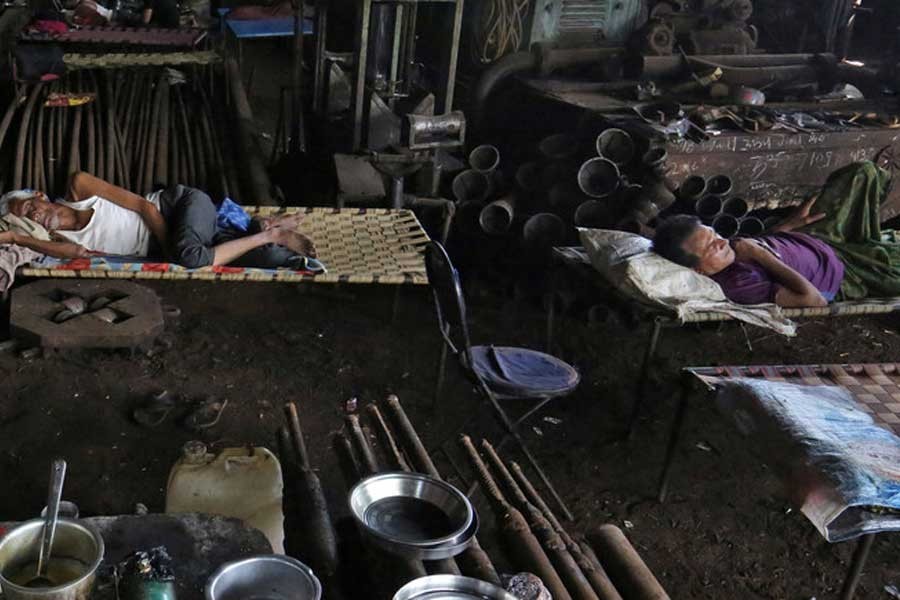The Covid-19 pandemic has been taking a heavy toll, in terms of life and livelihood, since it first emerged in the Chinese city of Wuhan in December last year.
No country has been spared. The intensity of infection and rate of fatality do, however, vary from one country to another. The impact of the pandemic on economies across the globe has also been not the same; some have suffered more and some less. Naturally, the big ones are the worst affected.
The world's largest US economy is the worst-hit. After the Great Economic Recession of 2009, nearly 20 million jobs were created over a decade in a spectacular recovery. But the gain was wiped out in a matter of few months since the outbreak of the viral disease. The unemployment rate jumped to nearly 15 per cent in April. However, the situation improved in the following months with the unemployment rate declining to 8.4 per cent in September. However the rate was 3.5 per cent in the corresponding month a year back. At the peak of the infection and fatality, hundreds of jobless and poor US citizens were seen forming long queues to collect free food distributed by different philanthropic organisations.
The performance of Bangladesh economy has been impressive during the recent years. It has been one of the fastest growing economies in Asia. The pandemic has also hit it hard. Thousands lost jobs and many more got their sources of income cut off as economic activities came to a standstill for months together. In such a situation, the reversal in the poverty trend was quite a natural phenomenon.
Bangladesh has been doing well in its bid to reduce poverty since 1991. Overall the rate of poverty came down to around 20 per cent in 2019 from 56.6 in 1990. The rate was 31.5 in 2010.
How has Covid impacted the poverty situation in Bangladesh? It is very difficult to get authentic statistics.
The Planning Commission (PC) estimates that the economic impact of the deadly pathogen has been severe. The rate of poverty which was 18.8 per cent in the fiscal year (FY) 2019 increased to 29.4 per cent in the FY 2020.
Yet the PC estimate appears to be conservative, to some extent, if viewed in the light of some projections made by a couple of private think tanks and a state research institute.
The Centre for Policy Dialogue (CPD) has projected that the poverty rate would swell to 35 per cent at the end of the current year.
Another research organisation, the South Asian Network on Economic Modeling (SANEM) forecast that the rate would double to 40.9 per cent.
The state research organisation the Bangladesh Institute of Development Studies, however, has made an optimistic projection taking into account the post-Covid recovery of the economy. It said that the overall rate of poverty would rise to 25.13 per cent. The poverty rate, according to it, would be higher in urban areas.
Independent economists have found the projection made by the PC on the poverty situation is not matching with the GDP growth estimate---5.24 per cent--- done by the Bangladesh Bureau of Statistics for the immediate past FY. The poverty rate should not be 29.4 per cent if the GDP growth was really at the level estimated by the BBS. The economists, it seems, are not ready to accept the GDP growth figure for the last FY.
Scepticism about the government statistics on growth and other macroeconomic indicators is an old issue. Even the multilateral agencies have expressed their reservation about the government data on several occasions.
Undeniably, the state statistical organisation, the BBS, needs to be manned by truly professional statisticians enjoying full independence in the matters of compilation and dissemination of data. Whether it will ever be done could be anybody's guess.
Poverty is directly linked to employment opportunities, both in formal and informal sectors.
Nearly 85 per cent of the country's workforce is engaged in the informal sector which has been battered by the pandemic. Millions had no work, even food, during the months between March and May this year. The economic activities started picking up gradually from early June, but the much-aspired rhythm is still awaited. None knows for sure when it would return. Only a part of the workforce which was unsettled during the so-called shutdown is being slowly absorbed. When old hands are still going without work, thousands of new faces are making their entry into the labour market every month.
What the economy needs now is substantial private and public investment in productive sectors that would generate enough jobs. Even during pre-Covid time, the generation of employment opportunities had been quite slow. The government has been investing a huge sum every year in mega projects that, however, would not generate enough jobs. None but the private sector is capable of churning out jobs incessantly if it makes sufficient investment in the economy. That is the area where the situation has not been at all palatable in recent years.
The private investment has remained more or less stagnated. The private sector credit growth is a testimony to that fact. The flow of credit to the sector has been well below the targets. The government should now try its best to woo maximum possible private investment. The lending rate is now at the level that the businesses have been pressing for many years. There could be some other barriers. The government should locate and address those properly.


